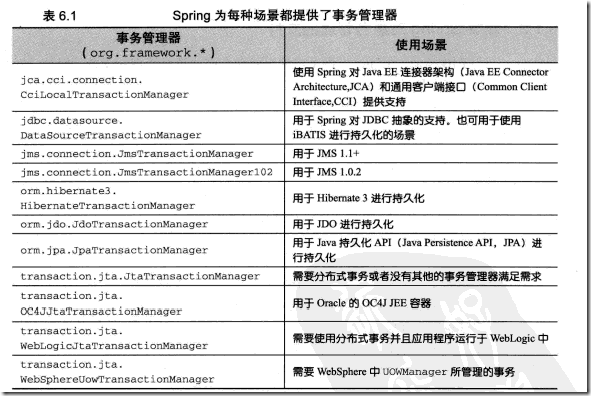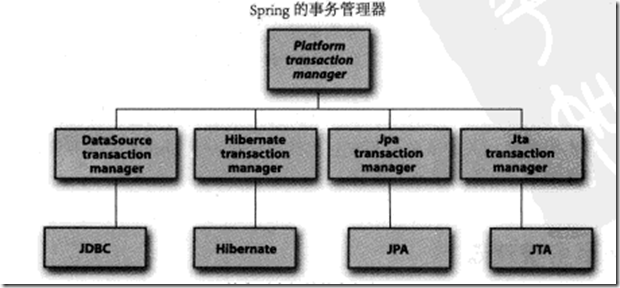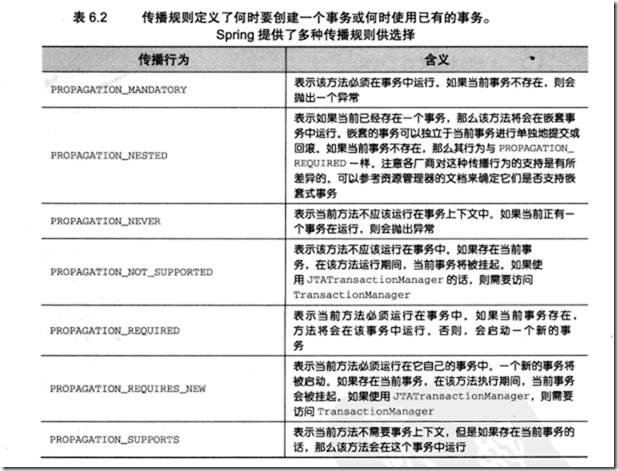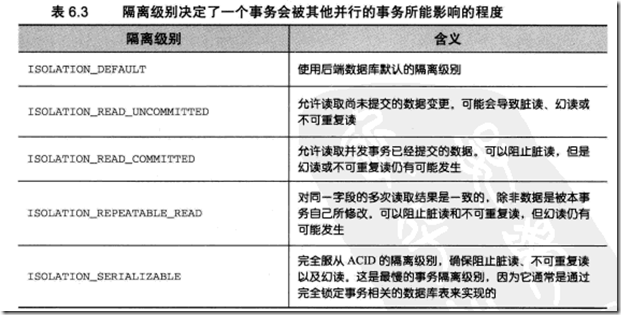摘录:
spring并不直接管理事务,而是提供多种事务管理器,他们将事务管理的职责委托给JTA或者其他持久机制所提供的平台相关的事务实现。
所以针对于JDBC的事务配置是:
针对于hibernate3的事务配置是:
针对于hibernate3 的某一个全部的配置是:
第五种方式:全注解
<?xml version="1.0" encoding="UTF-8"?> <beans xmlns="http://www.springframework.org/schema/beans" xmlns:xsi="http://www.w3.org/2001/XMLSchema-instance" xmlns:context="http://www.springframework.org/schema/context" xmlns:aop="http://www.springframework.org/schema/aop" xmlns:tx="http://www.springframework.org/schema/tx" xsi:schemaLocation="http://www.springframework.org/schema/beans http://www.springframework.org/schema/beans/spring-beans-2.5.xsd http://www.springframework.org/schema/context http://www.springframework.org/schema/context/spring-context-2.5.xsd http://www.springframework.org/schema/aop http://www.springframework.org/schema/aop/spring-aop-2.5.xsd http://www.springframework.org/schema/tx http://www.springframework.org/schema/tx/spring-tx-2.5.xsd"> <context:annotation-config /> <context:component-scan base-package="com.bluesky" /> <tx:annotation-driven transaction-manager="transactionManager"/> <bean id="sessionFactory" class="org.springframework.orm.hibernate3.LocalSessionFactoryBean"> <property name="configLocation" value="classpath:hibernate.cfg.xml" /> <property name="configurationClass" value="org.hibernate.cfg.AnnotationConfiguration" /> </bean> <!-- 定义事务管理器(声明式的事务) --> <bean id="transactionManager" class="org.springframework.orm.hibernate3.HibernateTransactionManager"> <property name="sessionFactory" ref="sessionFactory" /> </bean> </beans>
此时在DAO上需加上@Transactional注解,如下:
package com.bluesky.spring.dao; import java.util.List; import org.hibernate.SessionFactory; import org.springframework.beans.factory.annotation.Autowired; import org.springframework.orm.hibernate3.support.HibernateDaoSupport; import org.springframework.stereotype.Component; import com.bluesky.spring.domain.User; @Transactional @Component("userDao") public class UserDaoImpl extends HibernateDaoSupport implements UserDao { public List<User> listUsers() { return this.getSession().createQuery("from User").list(); } }
添加事务的另外的一种方法,通过编码的方式添加:
public void saveAction(Student std){ txTemplate.execute(new TransactionCallback<Void>() { @Override public Void doInTransaction(TransactionStatus arg0) { try { this.saveAction(std); } catch (Exception e) { arg0.setRollbackOnly(); throw e; } return null; } }); }
txTemplate 为TransactionTemplate 的实例,可以通过spring配置得到。
这样编码的事务能够完全的控制事务的边界,但是可以看到它是侵入行的,一般的情况下,不会要求如此精确的事务边界控制,通常的情况下事务的生命放在应用的程序代码之外,例如spring配置文件中。
spring中声明式事务
在XML中定义事务:
当然,这样的配置比较的麻烦,不如上面使用注解的方式,还是推荐使用注解的方式。








